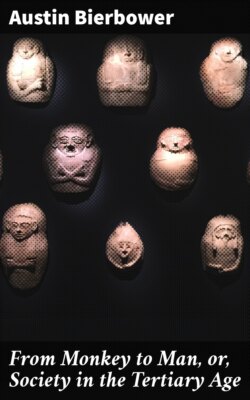Читать книгу From Monkey to Man, or, Society in the Tertiary Age - Austin Bierbower - Страница 9
На сайте Литреса книга снята с продажи.
CHAPTER VII.
ОглавлениеTable of Contents
We have said that the stories of the exploits of this war have been handed down in the religion of the Apes. This is due not so much to the achievements of the heroes as to the accounts of them by Shoozoo, who was much more active in relating battles than in fighting them; so that, as the heroes of the Trojan War owe more to Homer than to their own prowess, (for many great men lived before Agamemnon, whose exploits are forgotten for want of an imaginative historian); so the heroes of the fight about Cocoanut Hill are chiefly indebted to the Homer of the Apes for his reports of them. As gods, demi-gods, heroes and fair women rose from a ten days’ skirmish on the banks of the Scamander, so divinities, good and bad, had their origin in the Cocoanut Hill battles by reason of a good telling. Shoozoo was, fortunately, unlike Homer, both warrior and historian, and so, like Xenophon and Cæsar, made himself the chief character in his accounts. The other apes nearly all drop out of history, and their deeds are ascribed to him, who at the time of this story, was deemed the chief character in that conflict; showing that for future fame a good liar is better than a good fighter.
Thus the driving out of the snakes from Cocoanut Hill came in time to be wholly attributed to Shoozoo, so that, like St. Patrick, he was honored for the entire service of their expulsion. The great dragon, or flying alligator, of which he only spoke to Simlee as an excuse, was, in time, believed to have been actually killed by him, as a primitive St. George. The snake that had entered the mound of one of the apes, and gorged himself with its treasured fruits, and which was killed by the ape, was alleged to have been slain by Shoozoo while guarding great treasures in a cave, as Siegfried slew the Nibelungen dragon. The expulsion of the snakes from Cocoanut Hill found its way into various stories about a primitive pair of apes—Shoozoo and Simlee—whose fruit was stolen by snakes, for which the snakes were driven from the country; reversing the story of Adam and Eve, who took the fruit from the snake and were themselves expelled, instead of the snake. Had Adam been his own biographer, like Shoozoo, the story of Eden might have been reversed.
The long contest and great enmity engendered between the Monkeys and the Snakes, also caused in time the serpent to be taken to represent everything bad, and this conflict came in the Apian Mythology to be represented as the conflict between good and evil, in which a great serpent fought with Shoozoo and was overcome by him, but not altogether slain; so that, as in the Persian Theology, the contest between good and evil still went on, although Shoozoo was expected to come again in the great future, and put the serpent entirely under his feet.
Also, as the serpent came to represent evil, it was believed that the great winged alligator, with which Shoozoo fought, was the King of Evil, or Devil, and, that, being the chief of serpents, he led all assaults against the interests of the Apes. He was pictured with wings, tail, and great claws, and was supposed to be the power that ruled over Alligator Swamp, or the Land of the Bad. Apes frightened their children by saying that the great flying Alligator would come up out of the Swamp and devour them. Simian demonology thus had its birth. Like Juno springing from the head of Jove, it issued full grown out of the imagination of Shoozoo, with an alligator for its only foundation in fact.
It will thus be seen that the fight between the Monkeys and Snakes on Cocoanut Hill, which was important in the history, became more important in the mythology of the Apes, and, from its prominence in their profane and sacred traditions, it is natural that the Apes should make it the commencement of an epoch.
